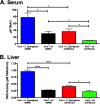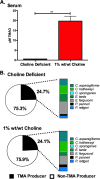Intestinal microbiota composition modulates choline bioavailability from diet and accumulation of the proatherogenic metabolite trimethylamine-N-oxide
- PMID: 25784704
- PMCID: PMC4453578
- DOI: 10.1128/mBio.02481-14
Intestinal microbiota composition modulates choline bioavailability from diet and accumulation of the proatherogenic metabolite trimethylamine-N-oxide
Abstract
Choline is a water-soluble nutrient essential for human life. Gut microbial metabolism of choline results in the production of trimethylamine (TMA), which upon absorption by the host is converted in the liver to trimethylamine-N-oxide (TMAO). Recent studies revealed that TMAO exacerbates atherosclerosis in mice and positively correlates with the severity of this disease in humans. However, which microbes contribute to TMA production in the human gut, the extent to which host factors (e.g., genotype) and diet affect TMA production and colonization of these microbes, and the effects TMA-producing microbes have on the bioavailability of dietary choline remain largely unknown. We screened a collection of 79 sequenced human intestinal isolates encompassing the major phyla found in the human gut and identified nine strains capable of producing TMA from choline in vitro. Gnotobiotic mouse studies showed that TMAO accumulates in the serum of animals colonized with TMA-producing species, but not in the serum of animals colonized with intestinal isolates that do not generate TMA from choline in vitro. Remarkably, low levels of colonization by TMA-producing bacteria significantly reduced choline levels available to the host. This effect was more pronounced as the abundance of TMA-producing bacteria increased. Our findings provide a framework for designing strategies aimed at changing the representation or activity of TMA-producing bacteria in the human gut and suggest that the TMA-producing status of the gut microbiota should be considered when making recommendations about choline intake requirements for humans.
Importance: Cardiovascular disease (CVD) is the leading cause of death and disability worldwide, and increased trimethylamine N-oxide (TMAO) levels have been causally linked with CVD development. This work identifies members of the human gut microbiota responsible for both the accumulation of trimethylamine (TMA), the precursor of the proatherogenic compound TMAO, and subsequent decreased choline bioavailability to the host. Understanding how to manipulate the representation and function of choline-consuming, TMA-producing species in the intestinal microbiota could potentially lead to novel means for preventing or treating atherosclerosis and choline deficiency-associated diseases.
Copyright © 2015 Romano et al.
Figures




References
Publication types
MeSH terms
Substances
Associated data
- Actions
Grants and funding
LinkOut - more resources
Full Text Sources
Other Literature Sources
Molecular Biology Databases

